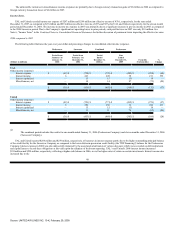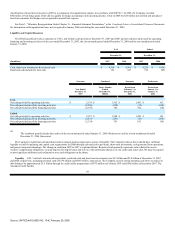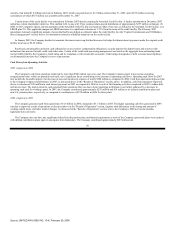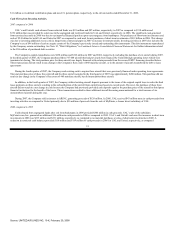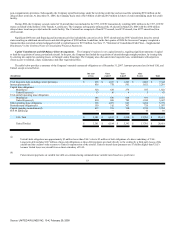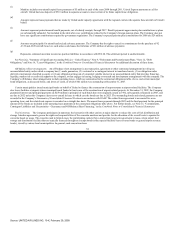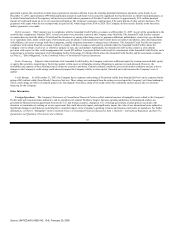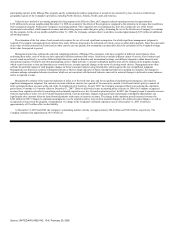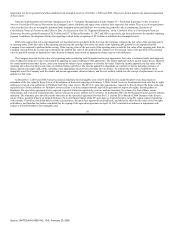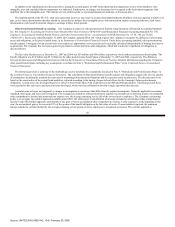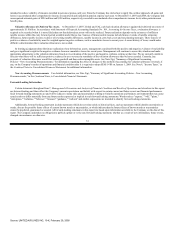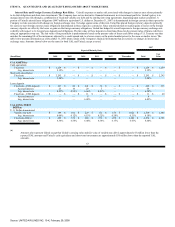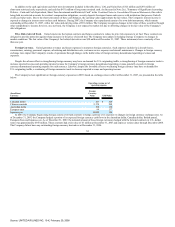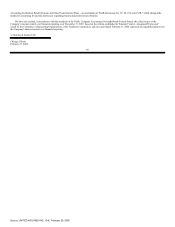United Airlines 2007 Annual Report Download - page 58
Download and view the complete annual report
Please find page 58 of the 2007 United Airlines annual report below. You can navigate through the pages in the report by either clicking on the pages listed below, or by using the keyword search tool below to find specific information within the annual report.
participating carriers in the Mileage Plus program, and by estimating the relative proportions of awards to be redeemed by class of service within broad
geographic regions of the Company's operations, including North America, Atlantic, Pacific and Latin America.
Under the new method of accounting adopted for this program at the Effective Date, the Company reduced operating revenue by approximately
$158 million in the eleven months ended December 31, 2006 to account for the effects of the program as compared to the reduction in revenues that would have
been recognized using the Predecessor Company's accounting method. The Company's new accounting policy does not continue the use of the former
incremental cost method, which impacted revenues and advertising expense under that prior policy. Assuming the use of the Predecessor Company's accounting
for this program, for the eleven months ended December 31, 2006, the Company estimates that it would have recorded approximately $27 million of additional
advertising expense.
The estimation of the fair value of each award mile requires the use of several significant assumptions, for which significant management judgment is
required. For example, management must estimate how many miles are projected to be redeemed on United, versus on other airline partners. Since the equivalent
ticket value of miles redeemed on United and on other carriers can vary greatly, this assumption can materially affect the calculation of the weighted-average
ticket value from period to period.
Management must also estimate the expected redemption patterns of Mileage Plus customers, who have a number of different award choices when
redeeming their miles, each of which can have materially different estimated fair values. Such choices include different classes of service (first, business and
several coach award levels), as well as different flight itineraries, such as domestic and international routings, and different itineraries within domestic and
international regions of United's and other participating carriers' flight networks. Customer redemption patterns may also be influenced by program changes,
which occur from time to time and introduce new award choices, or make material changes to the terms of existing award choices. Management must often
estimate the probable impact of such program changes on future customer behavior using limited data, which requires the use of significant judgment.
Management uses historical customer redemption patterns as the best single indicator of future redemption behavior in making its estimates, but changes in
customer mileage redemption behavior to patterns which are not consistent with historical behavior can result in material changes to deferred revenue balances,
and to recognized revenue.
Management's estimate of the expected expiration of miles as of the fresh-start date, and for recognition of expiration post-emergence, also requires
significant management judgment. For customer accounts which are inactive for a period of 36 consecutive months, it had been United's policy to cancel all
miles contained in those accounts at the end of the 36 month period of inactivity. In early 2007, the Company announced that it was reducing the expiration
period from 36 months to 18 months effective December 31, 2007. Under its deferred revenue accounting policy effective in 2006, the Company recognized
revenue from expiration of miles by amortizing such estimated expiration over the 36 month expiration period. In 2007, the Company began to amortize revenue
from the expiration of miles over an 18 month expiration period. Current and future changes to program rules and program redemption opportunities can
significantly alter customer behavior from historical patterns with respect to inactive accounts. The change in the expiration period increased revenues by
$246 million in 2007. Changes to expiration assumptions or to the expiration policy may result in material changes to the deferred revenue balance, as well as
recognized revenues from the program. A hypothetical 1% change in the Company's estimated expiration rate as of December 31, 2007 would have
approximately a $21 million effect on the liability.
At December 31, 2007 and 2006, the Company's outstanding number of miles was approximately 488.4 billion and 508.8 billion, respectively. The
Company estimates that approximately 416.6 billion of
57
Source: UNITED AIR LINES INC, 10-K, February 29, 2008



